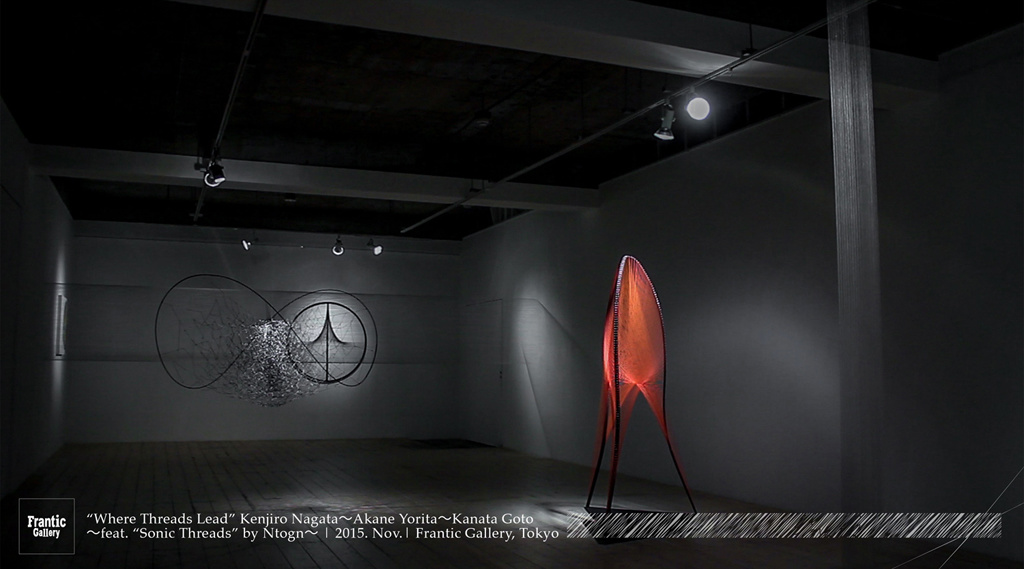"Where Threads Lead"
October 30 - November 1.2015
Frantic Gallery, Tokyo


An object made of threads ― if it can be called “an object” and if we can so easily apply “made” to something composed of stretched threads ―, how to locate it inside art categories? Well, it is obviously not a painting…, but the canvas itself is composed of nothing but hemp threads; the perspective in paintings ― the space itself ― starting with early Renaissance was created with the help of threads and later they were imaginary twisted and knotted in vertigo of art of Baroque; not to mention threads affinity to (out-)line and consequent link to the formation of figure in general. Due to its immaterial character (what can be less related to matter then a formation of elongated cords) and anti-representational stance (threads don’t have a “face” like most of the objects) neither it is a sculpture…, but at the same time it stays a major sculptural tool, being more than anything related to plasticity (it is plasticity in itself, so plastic that it can get entangled), entering into original and in-tense dialog with space (it is not just taking it, it absorbs space, underlines it, trans-fix it).
We get the impression that threads are always here, in art, but always stay invisible, unnoticed. As if Threads are in some kind of blind spot in the room of art. Whether due to its radically minimal character (what can be more expressively humble than a thread, as if it is the last step before being nothing) or because of its always instrumental/technical/applied character (as if thread was always involved but was supposed to be taken out from art after it’s done, like scaffolding are taken out from the facade of the building after it is finished), thread has never been thought as a genuine part of art. Even now in contemporary art threads are either biennial or art fair entrance bound installations (more related to light excitement of the visitors than pieces with critical weight) or as an object “pulled out” from architect’s studio as one of his “complimentary materials”: thread is still in obscurity as if it is provoking the continuous resistance of distinctive discourse of fine art.
Re-acting to this state of affairs, Frantic Gallery invites three visual artists and one musician to present their Threads and try to shed some light on the real significance, potential and actual role of this phenomenon in art and those vast anthropological fields it is connected with. The “Where Threads Lead” exhibition has no formal limits. In reverse, we would like to research vectors, exposing the unconscious work of threads: starting with the exploration of those thinking paths each artist took following his/her own personal tread end ending with the disclosure of those countless directions threads point to both as a material as well as a “final object”.
Threads take us to mythology and can help Ariadne to lead Theseus from the labyrinth playing here a role of salvation tool or, in reverse, they can lead to the spider net, to the symbolism of feminity/mother and psychological trap; threads are interwoven in major material bases of art like already mentioned canvas, worm produced silk, tapestry or carpets; they enter into a particular relationship with space and show enormous ability to bring into play and intensify the light and shadow they entwine; threads never lose powers of a threat while being in passed over in silence affinity with bondage in sadism and masochism and BDSM culture in general; threads can always remind us about their navel-like link with body where they penetrate us as veins and nerves being totally at home in the corporeal dimension as well, finally they enlace our languages entering into endless idiomatic expressions and staying always present in our speech - here are just few directions we can start with and in spite of the risk and all possible misfortunes that can happen on the way don’t fix the desirable arrival point but see… where threads lead us.
糸で作られたオブジェ(それをオブジェと呼ぶことができるのならば、あるいは糸が構成するものに対してたやすく「作られた」という言葉を与えることができるのであれば)、それをアートにカテゴライズするにはどうすればよいでしょうか。それは当然「絵画」ではありえません。しかし、カンヴァスは他でもなく麻の糸によって作られているのはもとより、ルネサンスに始まる絵画の遠近法——すなわち空間それ自体——は糸によって創造され、さらにめまいの時代であるバロックに至ると、糸は想像的によじれ始めました。したがって糸と(アウト)ラインの関係性に言及するにあたっては、否応なく形象全般に言及せざるをえないのです。
非物質的性質(引き伸ばされたコードの形状以上に物質からかけ離れたものがあるでしょうか)と反表象的なスタンス(糸は、「顔」がないという点において大多数の物と異なっています)は、糸を彫刻からも引き離します。しかし同時に糸は彫刻の主要なツールのひとつであることも事実であり、他のどの素材よりも可塑性を備えています(糸が「可塑性」そのものであり、それはもつれさせることができるほどの可塑性なのです)。そして、非常な独自性と緊張感をもって空間と対話(それは空間を掴むだけでなく、吸い込み、下線を引き、貫通させます)します。
糸は常に、ここ、美術の歴史に絶え間なくあるにもかかわらず、見えることなく、気付かれもしない存在になっているような印象を受けます。まるで糸は美術の死角にあるかのように。極端にミニマルな特質(無を前にしたステップのような…、糸よりもつつましやかなものがあるでしょうか)や常に手段、テクニック、応用へ向けられるという側面(必ず存在しているにも関わらずアートが完成した途端に引き抜かれる様子は、建物が竣工すると取り外される工事の足場を想起させます)から、糸がアートの真の一部に据えられることはありませんでした。現在のコンテンポラリーアートの領域においてでさえ、糸はビエンナーレやアートフェアのエントランス付近の(批評的重量よりも、観客を軽く驚かせることに重点がおかれている)インスタレーション、あるいは建築家のスタジオから「二次的な補足材料」として取り出されるものにとどまっています。今でも、糸は不明瞭なところから伸びてきて、ファインアートの弁別的なディスクールに抵抗を与えるものなのです。
このような現状に対する反応として、Frantic Galleryではヴィジュアルアーツの作家たちと一名のミュージシャンを招いて各々の「糸」を表現してもらうことにします。それは、アートのなかで糸という現象が本来どのような意義や可能性を持っていて、実際にどんな役割を果たすのか、そして多様な人類学的な領域と糸がどのようにして繋がるのか——を照らし出そうという試みです。「糸の導くほうへ」展には形式的なリミットがありません。むしろ形式の型に逆らって、糸のベクトルを探求しそれぞれの作家が糸に導かれて得た思考を辿り、素材として、また「最終的な対象」としての糸が指し示す無数の方向線を発見するにまで、糸の無意識の働きを暴露することを目的としています。
糸はわたしたちを神話の世界へと導きます。あるときにはアリアドネが迷宮からテセウスを救い出す救済の道具となり、またあるときには蜘蛛の巣、すなわち女性性/母性の象徴、心理学な罠ともなりうるのです。糸はすでに述べたカンヴァスをはじめ、蚕が吐き出す糸から作られるシルクやタペストリー、カーペットといったアートの基礎に織り込まれている物体であり、空間と特殊な関係性を築き、絡み合う光と闇を相互に強く作用させ合う能力を持っています。糸は——脅かすという作用を決して失わないまま、サディズム/マゾヒズムの緊縛やBDSMの文化全体との静かな近親性を保っています。糸は静脈と神経としてわたしたちの体を貫通します。そして無数の慣用的表現に織り込まれ、わたしたちの言語をもつれさながら、いつでもわたしたちの会話に居座っているのです。これらはスタートするためのいつくかの方向を示しています。道中でリスクや不運に見舞われる可能性があるとしても、望ましい到達点を設定するなどということはせずに進みましょう。糸の導くほうへ。